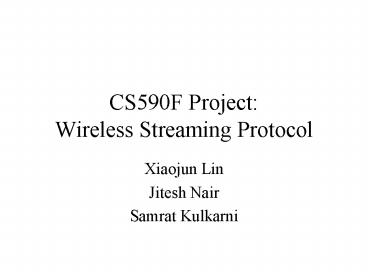CS590F Project: Wireless Streaming Protocol - PowerPoint PPT Presentation
1 / 13
Title:
CS590F Project: Wireless Streaming Protocol
Description:
Live Friendly with TCP on wired Internet. Responsive to changing network conditions. ... TCP Friendly Rate Control. Act on Congestion Loss only. Using the ... – PowerPoint PPT presentation
Number of Views:45
Avg rating:3.0/5.0
Title: CS590F Project: Wireless Streaming Protocol
1
CS590F Project Wireless Streaming Protocol
- Xiaojun Lin
- Jitesh Nair
- Samrat Kulkarni
2
Schedule
- Introduction and motivation
- Assumptions and goals
- Techniques
- Differentiating the loss
- Quality control using FEC
- TCP-friendly rate control
- Coupling between CC and FEC
- Contributions conclusion
3
Introduction
- Background
- Proliferation of Multimedia Content
- Increasing rate of Wireless systems
- 3GUMTS(384k to 2M), EDGE(384k).
- More Scalable Video Coding Technology
- MPEG 4 etc.
- Industries www.solidstreaming.com
- Wide Acceptance of Video to handheld is possible!
4
Assumptions and Goals
Video Source
- Wired-wireless interaction
- Wireless channels is at the last hop
- Competes with other flows on the internet
- Wireless loss at the last hop
Internet
Wireless Gateway
wireless
Mobile
5
Objective
- Our Wireless Streaming Protocol will
- Maximize perceived quality at the receiver given
network conditions. - Live Friendly with TCP on wired Internet
- Responsive to changing network conditions.
6
DETECTING CONGESTION AND WIRELESS LOSSES
CONGESTION LOSS
SENDER
WIRELESS GATEWAY
INTERNET
WIRE LESS LOSS
- DECOUPLE THE LOSSES SEEN BY SENDER INTO WIRELESS
AND WIRELINE LOSSES - LEVERAGING THE KNOWLEDGE OF THE WIRELESS GATEWAY
IN DETECTING CONGESTION LOSSES.
RECIEVER
7
KEY VARIABLES
GLOBAL_SEQUENCE_ This is a non negative
monotonically increasing number. Each packet has
a unique GLOBAL_SEQUENCE_ number. WG_COUNT_ This
is a non negative monotonically increasing number
set by the wireless gateway.
DIFFERENCE IN THE VALUE OF THE GLOBAL_SEQUENCE_
AND WG_COUNT_ INDICATES A CONGESTION
LOSS DIFFERENCE IN THE VALUE OF THE WG_COUNT_
AND THE NET PACKETS RECEIVED AT THE RECIEVER
INDICATES THE WIRLESS LOSS
8
Packet Format
- From Sender
- GLOBAL_SEQUENCE_
- WG_COUNT_
- For each block block indicates a chunk of data
which is packetized. This is in the FEC scheme.
(think of GOP). - FEC_MAX_ block size
- FEC_MIN_ minimum number of packet required to
decode. - LOCAL_SEQUENCE_ This is a non negative
monotonically increasing number. Each packet in a
block has a unique local sequence number. - From Receiver
- PACKETS_EXPECTED
- CONGESTION_LOSS
- WIRELESS_LOSS
9
Quality Control using FEC
Quality controller
Fair rate
Right amount of redundancy.
Loss Prob.
- Scalable Codecs e.g. MPEG4
- FEC code fec_min_, fec_max_
- Quality perceived at the receiver
10
Quality Control using FEC
- Model for perceived quality at the receiver
- Let m be the number of packets arrived at the
receiver - Maximize expected quality over fec_min_
- subject to
11
TCP Friendly Rate Control
- Act on Congestion Loss only
- Using the approach in Floyds paper.
12
The Whole Picture
- Sender send out FEC-coded stream.
- Receiver collect statistics related to congestion
loss and wireless loss - At the sender
- Congestion loss ? raw rate
- Raw rate loss ? redundancy, layer, net_rate
- Raw rate net_rate fec_max_ / fec_min_
13
Contribution and Conclusion
- Combined Source/Channel Coding for transmitting
multimedia to wireless terminals. - require assistance at the wireless
gateway/basestation to detect different source of
losses. - First step towards multimedia to your hand!































